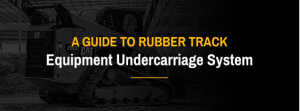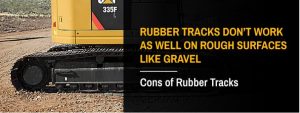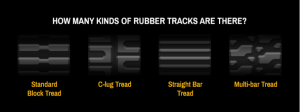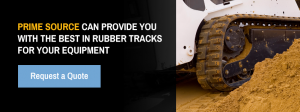
When you’re considering whether to use rubber tracks vs. steel tracks for your loader, skidder or mini excavator, rubber tracks offer numerous benefits and lower costs than steel tracks. Well, both types have their uses, and choosing between the two is not something you should do on a coin toss. Knowing the benefits of rubber tracks and how to maintain them will help you do a better job and ensure the tracks you do purchase remain in great shape for a longer period.
Ultimately, you should base your decision on how you will be using your rubber tracks, including the weather conditions and type of service for which you will be asking them to perform, and other important items like the comfort of the ride, durability of the tracks and the cost.
Jump to Section
- Why Is It Important to Buy from a Trusted Rubber Track Supplier, Rather Than an Aftermarket Supplier?
- Prime Source Can Provide You With the Best in Rubber Tracks for Your Equipment
Pros of Rubber Tracks
You can find rubber tracks for excavators, rubber tracks for skid steers, rubber undercarriage for mini excavators and multi-terrain rubber track loaders.
What are some of the advantages of using rubber tracks?
- Rubber tracks perform much better than steel tracks on softer ground. Steel tracks will often tear up turf or other kinds of sod. But rubber tracks glide across grass, dirt or any soft surface.

- Rubber tracks are much quieter than steel tracks. While most operators will wear a noise-canceling headset, rubber tracks absorb far more noise than steel tracks, which makes them an ideal choice if you are working in an area where loud noises would cause a problem.
- Rubber tracks allow you to move faster. No, you’ll never break the speed record in your equipment, but the reduced vibration of rubber tracks means you can drive them faster than machinery with steel tracks.
- Rubber tracks allow you to work more comfortably. The flexibility of rubber tracks means you or your employees will be more comfortable than working in a machine outfitted with steel tracks. The machine operator will be far less fatigued at the end of a hard day in a machine with rubber tracks.
- Rubber tracks have lower maintenance costs. We’ll talk a bit below about how to maintain your rubber tracks, but if you maintain your machine with rubber tracks carefully, you will spend a lot less money on maintenance over the long run.
- Rubber tracks have a longer effective life. And since rubber tracks cost much less than steel tracks, when the time comes to replace them, it’s not such a big financial hit on your pocketbook.
Cons of Rubber Tracks
Nothing is perfect, of course, and even rubber tracks have a few flaws.
- Rubber tracks hate the sun. If you leave your machine with rubber tire tracks out in the sun, your tracks will wear out much faster. No form of rubber reacts well to direct sunlight.
- Rubber tracks don’t work as well on rough surfaces like gravel. It’s not that rubber tracks can’t operate on a service like gravel or rocks, but they will not operate as well as on a smoother surface, and it significantly reduces their lifespan.

- Rubber tracks don’t handle curbs well. Driving your machine over curbs will put a lot of strain on your rubber tracks, which can lead to de-tracking, the worst problem for a machine with rubber tracks. Even if your tracks remain on your machine, the stress of going over the curb can cause the tracks to lose chunks of rubber, which can often lead to more severe problems.
- Rubber tracks don’t work well in environments full of contaminants. You won’t want to use rubber tracks on your machine if you’re working in a farmyard full of manure or a worksite contaminated with chemicals or oil. These contaminants can cause the rubber to deteriorate quickly.
How Many Kinds of Rubber Tracks Are There?
Rubber tracks come in four basic designs: staggered block tread, C-lug tread, standard bar tread and multi-bar tread.
- Standard block tread: Probably the most popular form of rubber track tread, it is particularly well-suited for use on hot paved surfaces and gravel. They are also useful in a wide range of working conditions, such as on finished lawns, clay, asphalt, sand and even mud.
- C-lug tread: These durable rubber tracks have notches cut out of each block. They deliver increased traction and better handling on asphalt, mud, concrete, clay, sand or gravel.
- Straight bar tread: Straight bar tread gives maximum traction, and so is ideal for use in wet or muddy terrain. It greatly reduces your chances of getting stuck in the mud.
- Multi-bar tread: This is the ideal tread when you need to move between two different types of terrain, like a softer groundcover and a harder surface like concrete. Many operators also like to use it in snowy conditions.

In truth, all rubber tracks are suitable for just about any situation. But if you know you’re going to be working in a particular kind of environment, choosing the right track will provide specific benefits.
Rubber Track Equipment Maintenance Tips
So when you’ve decided to use rubber tracks on your machinery, what can you do to not only make the job easier and faster, but also keep your rubber tracks in good operating condition for a much longer time? Here’s a guide to rubber track preventive maintenance.
- The three-point turn: Whenever possible, make a three-point turn in your machine rather than swinging in a 180-degree arc, especially if you’re working in a compact track loader. Why? It reduces side wear on the tracks, which is a real issue when you’re working on pavement or some other form of hard surface.
- Maintain the machine’s undercarriage: if you notice undercarriage parts are wearing out, replace them as quickly as you can. Bad sprocket teeth pull chunks from tracks, and overused rollers cut its rolling area.
- Keep tracks clean: This advice goes hand-in-hand with the above tip. Pressure-wash your tracks at the conclusion of every workday. It’s also a good time to take out any embedded foreign objects from the tracks, and gives you an opportunity to look for tracks that are missing components or becoming worn, cracked or loose.
- Maintain correct tension: Some operators seem to think if you keep track tension tighter than the recommended level, the tracks will last longer, but this is a mistake. Too much tension will cause premature wear and results in greater use of fuel. It’s a good idea to check the tension every 50 to 100 hours you use the machine, but base the frequency of your checks on the conditions of your tracks. If you notice they’re wearing out, you need to check more frequently. It’s essential to maintain correct tension on rubber tracks.
- Avoid too little tension: While too much tension is not ideal, so is too little tension. Under-tensioning can allow your machine to walk out of the rubber track, endangering your operator and causing significant damage to the machine. It’s always a better idea to keep the tracks a little bit looser rather than a little bit tighter, but if you keep them too loose, you’re asking for trouble.
- Make sure you have the right fit: Your machine needs the right length and pitch of rubber track to match the machine’s sprockets. Poorly fitting rubber tracks result in premature wear, not only to the rubber tracks but also to the sprockets. Tracks should match the machine’s horsepower to avoid premature wear, as well.
- Don’t look back: Always keep your machine moving in a forward direction. If you start to travel in reverse, especially at a higher speed, this will stress your tracks. Remember, rubber tracks are primarily designed for forward use.
- Rotate your tracks: In the same way it’s a good idea to rotate tires on your car, it’s also smart to rotate rubber tracks on your machine periodically. It will give you more even tread wear. And just like your tires on your regular car, if you need to replace one, you also need to replace the corresponding track on the other side. If you only replace one rubber track, you’ll experience uneven track wear. It may cost a little more than just replacing one rubber track in the short run, but you’ll save money and deal with fewer problems in the long run.
- Avoid sunlight: We mentioned this tip above, but just to reiterate, don’t park your machine in direct sunlight for a long time. Find some shade or cover the rubber tracks with a tarp. This maintenance tip can double the lives of your rubber tracks.
- Easy there, big fella: All rubber tracks wear out under heavy use, so try not to move them around when you’re not using them on a job. It’s also a good idea to avoid slopes and making sharp turns — remember, three-point turns are the answer.
- Rubber track solutions: When you’re not using rubber tracks on your machine, store them in a cool, dry area, and place them on their sides in a relaxed position to prevent crimps and folds. If you leave them on your machine, operate it once every couple of weeks for about five minutes to keep the tracks flexible and help them maintain their shape.
What Are the Signs I Need to Replace My Rubber Tracks?
If you maintain a regular maintenance schedule, the chances are excellent you’ll notice when your tires have become too worn or too shredded. But here are a few ways of telling if you might need to replace your rubber tracks.
You have trouble remembering the last time you checked the tension of your tracks.
If your track tension is too tight, the tracks wear out faster. And if they are too loose, there’s a higher risk they will slip or de-track, which can cause chunking or cutting. Another problem with not paying attention to your track tension is your tracks will lose their proper shape, which also contributes to increased wear and tear over time.
Your tracks are filthy, and you don’t clean them regularly.
As we noted above, the cleaner your tracks are, the longer they last. Tracks that are dirty and full of rocks and debris will wear out much faster than tracks you clean every day after the job.
You clean your tracks, but pay no attention to your undercarriage.
You can’t have one without the other. What’s the sense in keeping your tracks very clean, but not bothering to clean up the dirt and debris caught in your undercarriage? That could result in your tracks wearing out from the inside out, rather than from the outside in. Also, a dirty undercarriage will mean more damaged parts and components, which means you’ll have to spend more money, frustration and time on repairs.
Why Is It Important to Buy from a Trusted Rubber Track Supplier, Rather Than an Aftermarket Supplier?
The manufacture of each rubber track and the components that make it have a huge effect on the quality and durability of each track. When you buy from a trusted supplier, who works with familiar brands and names like Caterpillar, you know you are purchasing parts that have been designed and tested so your machine will produce maximum productivity and your tracks will last for an extended time.
You may pay less for aftermarket tracks, but you need to buy them more often. In the long run, you end up paying more for aftermarket tracks than buying your tracks from a trusted supplier that deals in quality equipment.
Prime Source Can Provide You With the Best in Rubber Tracks for Your Equipment
Prime Source Parts and Equipment knows how vital it is for you to keep your machinery up and running. We can help you with all your undercarriage needs, and all our parts, including rubber tire tracks, come from trusted brands and names.
Our talented and knowledgeable staff want to help you find the right part for your machinery, regardless of its brand or make. When you are looking for the best in rubber tracks for your loader, skidder or mini excavator, or tracks that will give you the best deal for your money, help increase your productivity and keep your customers happy, we want to help you.
You can reach us at 704-597-0030, request an online quote or visit our contact page. You will always get a prompt reply from a member of our knowledgeable staff.


